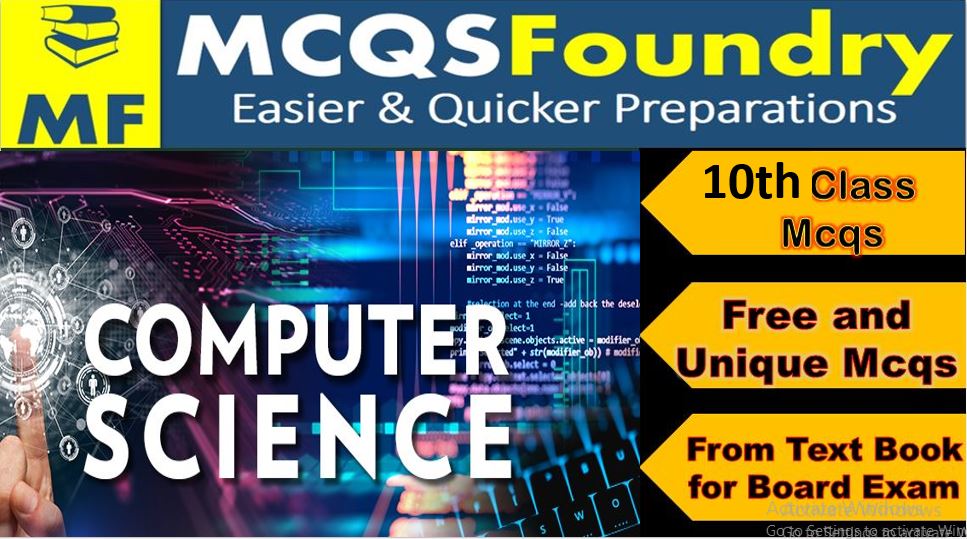MCQsFoundry.com brings to you 500+ 9th Class / Standard Computer Science Mcqs which are new and latest. These Mcqs are never published on internet so far. For full information about all PPSC / FPSC / CSS / PMS latest jobs visit theiteducation.com

CHAPTER NO : 1
INTRODUCTION TO COMPUTER
ENCIRCLE THE MOST APPROPRIATE ANSWER FROM THE FOLLOWING OPTIONS :
1: A computer is an
(a) Electric device
(b) Electronic device
(c) Electrostatic device
(d) Electromagnetic device
2: History of computer starts with
(a) Napier’s Bones
(b) Abacus
(c) Difference Engine
(d) Analytical Engine
3: Computer applications are
(a) Landing AIR planes
(b) Banking transactions
(c) Print of books
(d) All
4: Difference Engine was developed by.
(a) Blasé Pascal
(b) Charles Babbage
(c) Herman Hollerith
(d) Napier’s Bone
5: History of computers starts about
(a) 2000 years ago
(b) 3000 years ago
(c) 4000 years ago
(d) 5000 years, ago
6: Computer processes data and converts it into
(a) Theory
(b) Information
(c) Hypothesis
(d) Observation
7: Napier’s Bones and the slide rule were developed in.
(a) 17th Century
(b) 16th Century
(c) 18th Century
(d) 19th Century
8: Punch cards developed b
(a) Joseph Jacquard
(b) Howard H-Aiken
(c) Gottfrid
(d)Herman Hollerith
9: The slide rule was used till the middle of
(a) 50’s
(b) 60’s
(c) 70’s
(d) 80’s
10: John Napier, Created Napier’s Bones by using
(a) Bones
(b) Iron
(c) Rods
(d) Wires
11: Pascal’s Pascaline calculator had a system of
(a) Gears
(b) Rods
(c) Slides
(d) Bones
12: A German Mathematician, among the following, produced a machine similar to Pascal’s.
(a) Von Leibniz
(b) Charlas Babbage
(c) John Napier
(d)Herman Hollerith
13: Give the idea of Analytical Engine.
(a) Blaise Pascal
(b) Charles Babbage
(c) Herman Hollerth
(d) Napier’s Bone
14: vvENIAC was developed by.
(a) Howard H. Akin
(b) John Mauchly and J.P Eckert
(c) Charles Babbage
(d) None
15: Herman Hollerith developed
(a) Difference Engine
(b) Analytical Engine
(c) Punched card tabulator
(d) ENIAC
16: Babbage called his idea an
(a) Analytical Engine
(b) Electrical engine
(c) Electronic Engine
(d) Abacus
17: First electro-mechanical punched card tabulator was evolved in
(a) 1822
(b) 1833
(c) 1890
(d) 1942
18: Difference Engine was developed in.
(a) 1723
(b) 1833
(c) 1823
(d) 1822
19: Analytical engines were developed by.
(a) John Mauchly
(b) Blaise Pascal
(c) John Neumann
(d) None
20: The first commercial computer was.
(a) UNIVAC-I
(b) Mark- 1
(c) Abacus
(d) ENIAC
21: Which were the first commercially available computers?
(a) EDVAC
(b) ENIAC
(c) UNIVAC
(d) Both a & c
22: In early 1950’s which inventions among the following changed the image of the computer field
(a) Magnetic core memories, transistor circuit Elements
(b) ICS, magnetic core memories
(c) Transistors, ICS
(d) Transistors, EDVAC
23: From the 1950’s to 1960’s, computers were used in which fields?
(a) Accounting
(b) Payroll
(c) Inventory control
(d) All of these
24: VLSI stands for
(a) very low scale integration
(b) very large central integration
(c) very low central Integration
(d) very large scale integration
25: PCs were introduced in
(a) 1960’s
(b) 1970’s
(c) 1980’s
(d) 1990’s
26: Advancement in technologies continue to produce computers which are
(a) Cheaper
(b) Faster
(c) Accurate
(d) All of these
27: There are generations of computers.
(a) Four
(b) Five
(c) Six
(d) Three
28: First Generation of computers used.
(a) Transistors
(b) Vacuum Tubes
(c) ICs
(d) Processor
29: ENIAC, EDVAC and UNIVAC-I were the generation computers.
(a) First
(b) Second
(c) Third
(d) Fourth
30: Were used in 2nd generation computers.
(a) Transistors
(b) Vacuum Tubes
(c) ICs
(d) Processor
31: IBM 1400 were the generation computers.
(a) First
(b) Second
(c) Third
(d) Fourth
32: The third generation of computers used.
(a) ICs
(b) Microchip
(c) Vacuum Tube
(d) Processor
33: IBM system/360 series were the generation computers.
(a) First
(b) Second
(c) Third
(d) Fourth
34: Microprocessors were used in generation computers.
(a) 4th
(b) 2nd
(c) 3rd
(d) 1st
35: Microcomputers belong to the generation of computers.
(a) 4th
(b) 2nd
(c) 3rd
(d) 1st
36: Computer can be into types
(a) Two
(b) Three
(c) Four
(d) One
37: Hybrid computers are a mixture of computers.
(a) Digital
(b) Analog
(c) Both a & b
(d) None
38: Digital computers can be classified into types.
(a) Three
(b) Two
(c) Four
(d) One
39: Computers represent physical quantities like speed, weight.
(a) Digital
(b) Analog
(c) Hybrid
(d) All
40: Are the first computers being developed?
(a) Analog
(b) Digital
(c) Hybrid
(d) None
41: Analog clock, Analog Thermometer are the examples of which computer among the following .
(a) Digital
(b) Analog
(c) Hybrid
(d) Super
42: The computer languages that are close to machine language are called.
(a) Low Level Language
(b) High Level Language
(c ) Assembly Language
(d) Medium level
43: Fortran stands for.
(a) Formula Translation
(b) Formula Technique
(c ) Both a & b
(d) None
44: LISP language is widely used for work.
(a) Al
(b) System programming
(c) Application Programming
(d) All
45: FORTRAN was developed in.
(a) 1945
(b) 1957
(c) 1960
(d) 1967
46: C language is developed early.
(a) 1950’s
(b) 1960’s
(c) 1970’s
(d) 1980’s
47: Assembler is used to convert language programs into machine Language.
(a) Assembly
(b) HLL
(c) Pascal
(d) LLL
48: A computer cannot directly understand level language.
(a) Low
(b) High
(c) Middle
(d) None
49: Compiler is used to transform level language source code into machine language.
(a) Low
(b) High
(c) Middle
(d) None
50: Interpreter is used to convert high-level language programs into language.
(a) Machine
(b) High
(c) Middle
(d) None
